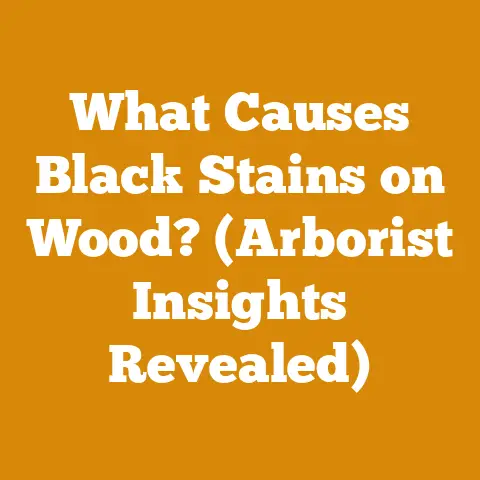Burning Pressure Treated Wood Safely (5 Insider Arborist Tips)
Imagine trying to extinguish a raging forest fire with a garden hose. That’s how effective burning pressure-treated wood in your fireplace is – except instead of water, you’re spraying toxic chemicals into your home. The question of whether or not to burn pressure-treated wood is a serious one, often met with strong opinions and a surprising amount of misinformation. As an arborist and someone who has spent years dealing with wood in all its forms, I’ve seen firsthand the dangers and the misconceptions surrounding this topic. I’m going to share some insider knowledge, not just about why you shouldn’t burn it, but also about how to handle it responsibly and safely. This isn’t just about following regulations; it’s about protecting your health, your family, and the environment.
Burning Pressure Treated Wood Safely (5 Insider Arborist Tips)
Pressure-treated wood is a common building material, prized for its resistance to rot, decay, and insect infestation. This resistance comes from chemical preservatives forced deep into the wood fibers. Burning this wood releases those chemicals, creating a hazardous situation. However, understanding the risks and implementing safe disposal practices is crucial. This guide will provide you with the knowledge and practical tips to handle pressure-treated wood responsibly.
Understanding Pressure-Treated Wood
What is Pressure-Treated Wood?
Pressure-treated wood is lumber that has been infused with chemical preservatives under high pressure. This process forces the chemicals deep into the wood, making it resistant to decay, insects, and fungal growth. The most common preservatives used historically were chromated copper arsenate (CCA), but due to health concerns, CCA has been largely phased out for residential use. Newer preservatives include alkaline copper quaternary (ACQ), copper azole (CA), and micronized copper azole (MCA). While these newer treatments are considered safer, they still pose risks when burned.
Why is it Used?
Pressure-treated wood is used extensively in outdoor applications where wood is exposed to moisture and soil. Common uses include:
- Decks and Patios: Provides a durable, long-lasting surface resistant to the elements.
- Fences: Protects against rot and insect damage, extending the lifespan of the fence.
- Playground Equipment: Ensures safety and longevity in high-use areas.
- Landscaping Timbers: Retaining walls, garden beds, and other landscaping projects benefit from the wood’s resistance to decay.
- Docks and Piers: Essential for structures in contact with water, where decay is a significant concern.
Identifying Pressure-Treated Wood
Identifying pressure-treated wood can be tricky, especially if it’s been weathered or painted. Here are some clues:
- Greenish or Brownish Tint: Freshly treated wood often has a slight green or brown tint due to the copper-based preservatives. This color can fade over time.
- Stamp or Tag: Look for a stamp or tag indicating that the wood has been pressure-treated and specifying the type of preservative used. This stamp may be on the end of the board or along its length.
- End Tag: The end tag will usually identify the treating company, the type of preservative, the intended use (e.g., “ground contact,” “above ground”), and the standard to which the wood was treated (e.g., AWPA standards).
- Drill Marks: The pressure treatment process often leaves small drill marks or incisions in the wood.
- Age: Wood purchased before 2004 is more likely to be treated with CCA.
The Dangers of Burning Pressure-Treated Wood
Health Risks
Burning pressure-treated wood releases toxic chemicals into the air, posing significant health risks.
- Arsenic: CCA-treated wood contains arsenic, a known carcinogen. Inhaling arsenic-laden smoke can lead to lung, skin, bladder, and liver cancers. Even short-term exposure can cause nausea, vomiting, and skin irritation.
- Data Point: A study by the EPA found that burning CCA-treated wood can release up to 7 grams of arsenic per kilogram of wood burned.
- Chromium: Chromium is another component of CCA and can cause respiratory problems, asthma, and allergic reactions. It can also damage the kidneys and liver.
- Data Point: The Agency for Toxic Substances and Disease Registry (ATSDR) notes that inhaling chromium compounds can increase the risk of lung cancer.
- Copper: While copper is less toxic than arsenic and chromium, inhaling copper oxide fumes can cause metal fume fever, a flu-like illness with symptoms such as fever, chills, and muscle aches.
- Other Preservatives: Newer preservatives like ACQ and CA contain copper and quaternary ammonium compounds. Burning these woods releases copper oxide and other potentially harmful chemicals, though their long-term health effects are still being studied.
- Data Point: Research from Oregon State University indicates that burning ACQ-treated wood releases copper at levels that can be harmful to aquatic ecosystems if the ash is improperly disposed of.
Environmental Impact
Burning pressure-treated wood not only harms human health but also pollutes the environment.
- Air Pollution: The smoke released from burning pressure-treated wood contains particulate matter, heavy metals, and toxic chemicals that contribute to air pollution. This can exacerbate respiratory problems and harm local ecosystems.
- Data Point: The EPA estimates that wood-burning stoves and fireplaces are responsible for a significant portion of particulate matter pollution in many areas, and burning treated wood only compounds this problem.
- Soil Contamination: The ash from burning pressure-treated wood contains concentrated levels of toxic chemicals. If this ash is spread on gardens or composted, it can contaminate the soil and be absorbed by plants.
- Data Point: A study published in the Journal of Environmental Quality found that ash from CCA-treated wood can significantly increase arsenic levels in soil, making it unsuitable for growing food crops.
- Water Contamination: Rainwater can leach chemicals from the ash into the soil and groundwater, contaminating water sources. This can harm aquatic life and pose risks to human health if the water is used for drinking or irrigation.
Legal and Regulatory Considerations
Burning pressure-treated wood is illegal in many areas due to the health and environmental risks.
- EPA Regulations: The EPA has strict regulations regarding the disposal of CCA-treated wood, including prohibitions on burning it. Violations can result in significant fines and penalties.
- Data Point: The EPA can fine individuals and businesses up to $37,500 per day for violating environmental regulations.
- State and Local Laws: Many states and local municipalities have their own regulations regarding the disposal of treated wood. These regulations may include restrictions on burning, landfill disposal, and recycling.
- Example: In California, it is illegal to burn treated wood in residential fireplaces or wood stoves.
- Insurance Implications: Burning pressure-treated wood can void your homeowner’s insurance policy if it causes a fire or other damage.
5 Insider Arborist Tips for Safe Handling and Disposal
Tip 1: Proper Identification is Key
Before handling any wood, it’s crucial to identify whether it’s been pressure-treated. Look for the telltale signs mentioned earlier: greenish or brownish tint, stamps or tags, and drill marks. If you’re unsure, err on the side of caution and treat it as if it’s been treated.
- Personal Story: I once encountered a pile of old lumber at a demolition site. It looked like ordinary wood, but upon closer inspection, I found faint stamps indicating it was CCA-treated. Had I not been vigilant, I might have unknowingly burned it, exposing myself and others to harmful chemicals.
- Actionable Step: Keep a magnifying glass and a bright light handy when inspecting wood. The stamps can be small and faded, especially on older lumber.
Tip 2: Safe Handling Practices
When working with pressure-treated wood, always wear appropriate personal protective equipment (PPE).
- Gloves: Wear gloves to prevent direct skin contact with the wood and the chemicals it contains. Nitrile gloves are a good choice as they are resistant to many chemicals.
- Dust Mask: When cutting or sanding pressure-treated wood, wear a dust mask or respirator to avoid inhaling wood dust.
- Eye Protection: Wear safety glasses or goggles to protect your eyes from wood chips and dust.
- Protective Clothing: Wear long sleeves and pants to minimize skin exposure.
-
Washing: After handling pressure-treated wood, wash your hands thoroughly with soap and water. Wash your work clothes separately from other laundry.
-
Data Point: A study by the National Institute for Occupational Safety and Health (NIOSH) found that workers who regularly handle treated wood without proper PPE have a higher risk of developing skin irritation and respiratory problems.
- Practical Tip: Designate a specific set of work clothes for handling treated wood to avoid cross-contamination.
Tip 3: Environmentally Responsible Disposal
The best way to dispose of pressure-treated wood is to take it to a designated disposal facility or landfill that accepts treated wood.
- Landfill Disposal: Most landfills accept pressure-treated wood, but it’s essential to check with your local landfill to confirm their policies. Some landfills may require the wood to be wrapped in plastic before disposal.
- Cost Consideration: Landfill disposal fees vary widely depending on your location and the amount of waste. On average, you can expect to pay between $50 and $100 per ton.
- Recycling: In some areas, pressure-treated wood can be recycled. Look for specialized recycling facilities that can safely process treated wood. These facilities typically grind the wood into small chips and use it as fuel in industrial boilers or as a component in composite wood products.
- Data Point: According to the Treated Wood Council, there are several facilities in the US that recycle treated wood, diverting it from landfills and reducing the demand for virgin timber.
- Avoid Burning: Never burn pressure-treated wood in fireplaces, wood stoves, open fires, or burn barrels. Burning releases toxic chemicals into the air and leaves behind contaminated ash.
-
Avoid Composting: Do not compost pressure-treated wood or use it as mulch in gardens. The chemicals in the wood can leach into the soil and contaminate plants.
-
Personal Story: I once worked on a project where we had a large quantity of CCA-treated wood to dispose of. Instead of burning it (which was out of the question), we contacted a local waste management company that specialized in handling hazardous materials. They provided us with the necessary containers and transported the wood to a designated landfill, ensuring it was disposed of safely and legally.
- Actionable Step: Before starting any project involving treated wood, research your local disposal options and plan accordingly. This will save you time and money in the long run and ensure that you’re handling the waste responsibly.
Tip 4: Minimize Cutting and Sanding
Whenever possible, minimize cutting and sanding pressure-treated wood to reduce the amount of dust and debris generated.
- Planning: Carefully plan your projects to minimize waste and the need for cutting. Use standard lumber sizes whenever possible.
- Pre-Cut Lumber: Consider purchasing pre-cut lumber from your supplier to reduce the amount of cutting you need to do on-site.
- Sharp Tools: Use sharp tools to make clean cuts with minimal dust. Dull tools create more friction and generate more dust.
- Wet Sawing: If you need to cut a large amount of treated wood, consider using a wet saw. The water helps to suppress dust and prevent it from becoming airborne.
-
Local Insight: I’ve found that local lumber yards are often willing to cut lumber to specific dimensions for a small fee. This can save you time and effort and reduce the amount of waste generated.
-
Data Point: Studies have shown that using a wet saw can reduce dust emissions by up to 90% compared to dry sawing.
- Cost Consideration: While a wet saw may require an initial investment, it can save you money on dust masks and other PPE in the long run.
Tip 5: Educate Others
One of the most important things you can do is to educate others about the dangers of burning pressure-treated wood. Share your knowledge with friends, family, and neighbors, and encourage them to handle and dispose of treated wood responsibly.
- Community Outreach: Consider organizing workshops or presentations on safe wood handling and disposal practices in your community.
- Online Resources: Share links to reputable sources of information, such as the EPA, the Treated Wood Council, and university extension services.
- Lead by Example: Demonstrate safe handling and disposal practices in your own projects.
-
Addressing Misconceptions: Be prepared to address common misconceptions about treated wood. For example, some people believe that it’s safe to burn treated wood if it’s been aged or weathered. This is not true. The chemicals remain in the wood regardless of its age or condition.
-
Personal Story: I once had a neighbor who was planning to burn a pile of old fence posts in his backyard. When I explained the dangers of burning treated wood, he was surprised and grateful. He had no idea that the wood was treated or that it could release harmful chemicals. We worked together to dispose of the wood properly, and he became a strong advocate for safe wood handling practices in our neighborhood.
- Actionable Step: Start a conversation with someone you know about the dangers of burning treated wood. You may be surprised at how many people are unaware of the risks.
Cost Considerations for Disposal
Disposing of pressure-treated wood isn’t free, and it’s crucial to factor these costs into your project budget. Let’s break down the potential expenses:
- Landfill Fees: As mentioned earlier, landfill fees typically range from $50 to $100 per ton. The exact cost will depend on your location and the specific landfill.
- Example: In my area, the local landfill charges $75 per ton for construction and demolition debris, including treated wood.
- Transportation Costs: You’ll need to transport the treated wood to the landfill or recycling facility. If you don’t have a truck, you may need to rent one or hire a hauling service.
- Rental Costs: Truck rental can cost anywhere from $50 to $200 per day, depending on the size of the truck and the rental company.
- Hauling Services: Hiring a hauling service can cost between $100 and $500, depending on the distance and the amount of material.
- Recycling Fees: Recycling facilities may charge a fee for accepting treated wood. This fee may be higher than landfill fees in some areas.
- Example: A recycling facility near me charges $120 per ton for treated wood, compared to the landfill fee of $75 per ton.
- Permitting Fees: In some areas, you may need a permit to dispose of large quantities of construction and demolition debris.
- Permit Costs: Permitting fees can range from $25 to $100 or more, depending on the local regulations.
- Labor Costs: If you’re hiring someone to handle the disposal, you’ll need to factor in labor costs.
- Labor Rates: Labor rates for construction workers typically range from $25 to $50 per hour.
Here’s a sample cost breakdown for disposing of 1 ton of pressure-treated wood:
| Item | Cost |
|---|---|
| Landfill Fee | $75 |
| Truck Rental | $75 |
| Labor (2 hours @ $30) | $60 |
| Total | $210 |
- Cost Optimization Tip: To save money on disposal costs, try to minimize the amount of treated wood you use in your projects. Plan carefully, use standard lumber sizes, and avoid over-ordering. You can also explore options for reusing treated wood in other projects, as long as it’s not used in direct contact with soil or water.
Alternative Wood Treatment Options
If you’re concerned about the health and environmental risks of pressure-treated wood, there are several alternative wood treatment options available.
- Naturally Durable Wood Species: Some wood species are naturally resistant to decay and insects, such as redwood, cedar, black locust, and osage orange. These woods don’t require chemical treatment and are a sustainable choice.
- Cost Consideration: Naturally durable wood species tend to be more expensive than pressure-treated wood. However, they can last longer and require less maintenance, which can save you money in the long run.
- Borate-Treated Wood: Borate-treated wood is treated with borate compounds, which are effective against insects and fungi but are less toxic than traditional preservatives. Borate-treated wood is suitable for interior applications and above-ground exterior applications.
- Data Point: Borate compounds have a low toxicity to mammals and are considered relatively safe for human health.
- Heat-Treated Wood: Heat-treated wood is heated to high temperatures in a controlled environment, which alters its chemical structure and makes it more resistant to decay. Heat-treated wood is a sustainable and environmentally friendly option.
- Cost Consideration: Heat-treated wood is typically more expensive than pressure-treated wood, but it offers superior durability and resistance to decay.
- Wood-Plastic Composites (WPC): WPC is a composite material made from wood fibers and plastic. It’s resistant to decay, insects, and moisture and requires minimal maintenance. WPC is a popular choice for decking, fencing, and other outdoor applications.
- Cost Consideration: WPC can be more expensive than pressure-treated wood, but it offers superior durability and requires less maintenance.
Here’s a cost comparison of different wood treatment options:
| Treatment Option | Cost per Board Foot | Durability | Environmental Impact |
|---|---|---|---|
| Pressure-Treated Wood | $1.50 | Moderate | High |
| Naturally Durable Wood | $3.00 | High | Low |
| Borate-Treated Wood | $2.00 | Moderate | Low |
| Heat-Treated Wood | $3.50 | High | Low |
| Wood-Plastic Composites | $4.00 | Very High | Moderate |
These prices are estimates and may vary depending on your location and the specific product.
- Personal Story: I recently built a deck using redwood instead of pressure-treated wood. While the redwood was more expensive upfront, I was able to avoid the health and environmental risks associated with pressure-treated wood. Plus, the redwood has a beautiful natural color and grain that will last for many years with minimal maintenance.
- Actionable Step: When planning your next project, consider using alternative wood treatment options instead of pressure-treated wood. Weigh the costs and benefits of each option and choose the one that best meets your needs and values.
Budgeting for Wood Processing and Firewood Preparation
While this article focuses on the dangers of burning treated wood, it’s important to briefly touch on the costs associated with proper wood processing and firewood preparation, assuming you’re dealing with untreated wood.
Timber Purchase or Harvesting Costs:
- Standing Timber: If you’re harvesting your own timber, you’ll need to factor in the cost of purchasing the standing timber. Prices vary greatly depending on the species, quality, and location of the timber.
- Data Point: According to the USDA Forest Service, the average stumpage price for sawtimber in the United States is around $300 per thousand board feet (MBF). However, prices can range from $50 to $1000 or more per MBF, depending on the species and quality.
- Purchased Logs: If you’re purchasing logs, you’ll need to factor in the cost of the logs themselves, as well as transportation costs.
- Log Prices: Log prices vary depending on the species, size, and quality of the logs. On average, you can expect to pay between $50 and $200 per ton for hardwood logs.
- Harvesting Costs: If you’re harvesting your own timber, you’ll need to factor in the costs of felling, skidding, and bucking the trees. These costs can vary depending on the terrain, the size of the trees, and the equipment you use.
- Logging Crew Costs: Hiring a logging crew can cost between $500 and $2000 per day, depending on the size of the crew and the complexity of the job.
Tool Maintenance:
- Chainsaw Maintenance: Chainsaws require regular maintenance, including sharpening the chain, cleaning the air filter, and lubricating the bar and chain.
- Maintenance Costs: Chainsaw maintenance can cost between $50 and $100 per year, depending on the amount of use.
- Splitter Maintenance: Log splitters also require regular maintenance, including changing the hydraulic fluid and lubricating the moving parts.
- Maintenance Costs: Log splitter maintenance can cost between $25 and $50 per year.
Labor Wages:
- Firewood Handlers: If you’re hiring someone to help you prepare firewood, you’ll need to factor in labor wages.
- Labor Rates: Labor rates for firewood handlers typically range from $15 to $25 per hour.
Permits:
- Harvesting Permits: In some areas, you may need a permit to harvest timber.
- Permit Costs: Harvesting permits can range from $25 to $100 or more, depending on the local regulations.
- Burning Permits: In some areas, you may need a permit to burn brush or debris.
- Permit Costs: Burning permits are typically free or low-cost.
Drying Time:
- Seasoning Firewood: Firewood needs to be seasoned (dried) before it can be burned efficiently. The drying time depends on the species of wood, the size of the pieces, and the climate.
- Drying Time: Hardwoods typically take 6-12 months to season, while softwoods take 3-6 months.
- Estimating Drying Time: You can estimate the drying time of firewood using the following formula:
Drying Time (months) = (Moisture Content (%) - Target Moisture Content (%)) / Drying Rate (% per month)
- Example: If you’re starting with wood that has a moisture content of 50% and you want to dry it to a target moisture content of 20%, and the drying rate is 5% per month, the drying time would be:
Drying Time = (50% - 20%) / 5% = 6 months
Current Industry Benchmarks and Statistical Data:
- Average Price per Cord of Firewood: The average price per cord of firewood in the United States is around $250, but prices can range from $150 to $400 or more, depending on the species of wood and the location.
Practical Tips for Cost Optimization and Budget Management:
- Harvest Your Own Timber: If you have access to timber, harvesting your own can save you money on log purchases.
- Use Efficient Equipment: Using efficient chainsaws and log splitters can reduce fuel consumption and labor costs.
- Season Firewood Properly: Seasoning firewood properly ensures that it burns efficiently and reduces the amount of wood you need to burn.
- Shop Around for Supplies: Compare prices from different suppliers to get the best deals on tools, equipment, and supplies.
Conclusion: A Responsible Approach
Burning pressure-treated wood is simply not worth the risk. The health hazards, environmental damage, and potential legal consequences far outweigh any perceived convenience or cost savings. By following these insider arborist tips, you can handle and dispose of pressure-treated wood safely and responsibly, protecting yourself, your community, and the environment. Remember, being a good steward of the land means making informed choices and prioritizing safety over short-term gains. That’s a fire you can feel good about.






